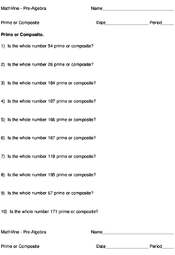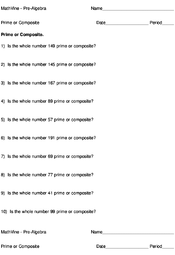Prime or Composite
Introduction
All whole numbers greater than 1 are either Prime or Composite numbers. Prime numbers have no factors except itself and 1. Composite numbers have at least one other factor.
For example, 7 is divisible by 7 and 1 and no other numbers, meaning it's a prime number. 8 is divisible by 8, 4, 2, and 1, meaning it is a composite number.
1 and 0 don't count as either prime or composite numbers.
Terms
Lesson
To work out if a number is prime or composite you can first to check if it has any factors. For example, you can easily check if the number is even. If it is, then it's not prime, because it can be divided by 2 (the only exception is 2, which is the only even prime number).
Another tactic you can use is to learn the common prime numbers.
The first 10 prime numbers are: 2,3,5,7,11,13,17,19,23,29
All the numbers in between are composite. As the numbers get higher, the gaps between prime numbers get bigger.
All composite numbers are composed of prime numbers multiplied together (which is why they are called 'composite numbers').
For example:
30 is a composite number, made up of three primes multiplied together.
All numbers above 1 are therefore either primes or composed of primes multiplied together.


